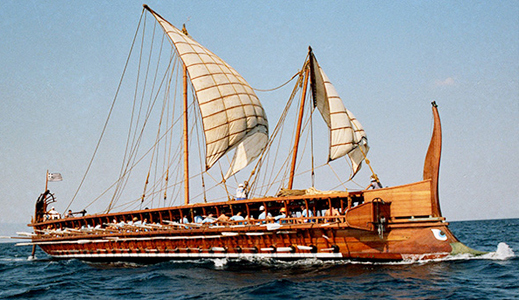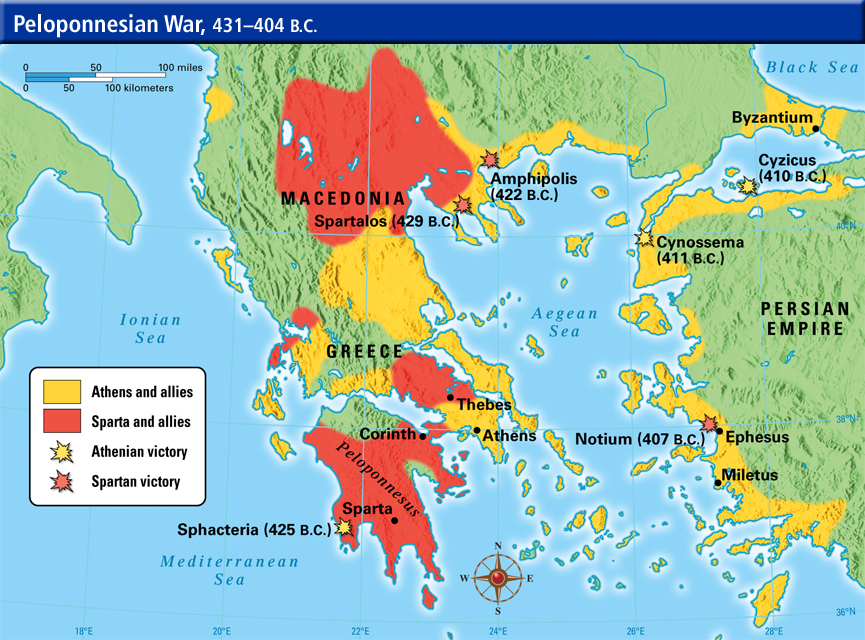In 431 BC began the war between Athens and the Peloponnesian League cities. On the side of Athens were fighting members of Delian-Attic Alliance and many Greek cities, with indirect help southern Italian and Sicilian cities. On the other side were all the Peloponnesian cities except Argos and Achaea (Corinthian colonies in Central Greece). The first part of the war lasted 10 years (431-421) and ended in peace. Once peace was disturbed, the war again led from 415-404 BC and ended with the defeat of Athens and the establishment of the Spartan hegemony.
There were many causes of the war. Cities Peloponnesian League fought with Athens for the country, the market and the imposition of political systems. Those battles were many, and they were completed with the thirty peace between Athens and Sparta 446 BC.
The first part of the Peloponnesian war
The first part of the war began after Athens imposed a ban on the Megarans use of port and having intervened in the conflict between Corinth and Corcyra. The first part of the war was led in Attica and the Peloponnese. In Attica Peloponnesians ravaged country under the leadership of Spartan king Archidamian and forced residents of Attica to retreat behind the walls of Athens. In the second year of the war was in Athens and Piraeus plague that destroyed a third of the Athenian population and demoralized Athenians. From plague in 429 BC Pericles died. After Pericles’ death, the most popular politician in Athens became Cleon, who asked for the fierce war of aggression, while on the other side stood Nicias, leader of oligarchs-the landowners who wanted peace. On the other side was the same dichotomy, Sparta wanted peace, Corinth war. By the 421 BC war was fought with variable happiness. Until then, the Spartans feared of rebellion of helots and were concerned for their citizens caught by the Athenians. In the Athens, the landowners led by Nicias were given the increasing power. In addition, the Allies reluctantly increased contribution for war operations. For peace the most lusted were Attic peasants whose lands were ravaged. In the spring of 421 BC a peace was concluded between the Athens and the Sparta for 30 years, known as the Peace of Nicias that was made on behalf of the Athenians. That’s how the both sides recognized the status quo before the war started. Athens and Sparta have pledged to return the occupied lands and prisoners.
Many members of the Peloponnesian League admitted the Peace of Nicias. It had not been recognized by Corinth, Megaras, Elis and Thebes as the Athens-Sparta peace were not taken their interests as well. In Athens, in other cities were fought an internal struggles in which the democrats and oligarchs used international situation. In the 415 BC at the head of the Athenians came Alcibiades, who decided to go to the military march on Sicily.



The second part of the war
In the spring of 415 BC the Athenian fleet under the command of Alcibiades, Nicias and Lamah went to Sicily under the pretext that they came to help the city of Segesta, that was attacked by the Syracusan, and actually to take Syracuse and ensure Athenian trade positions in Sicily. On the eve of the rush of Syracuse, Alcibiades received an order to return to Athens because he had to defend from the charges. But on the way back to Sparta, Alcibiades escaped. The Athenians attacked Syracuse led the whole under the command of Nicias and Lamah. To Syracusans, who were first severely repressed, the help came from Sparta, Corinth and other allies under the leadership of Spartan Gylippus, who with difficulties defeated the Athenians.
While the best of the Athenian units were occupied in Sicily, the Spartans under the command of King Agis took Attica Decelea fortress, where they prevented the supply of Athens and interfered with agriculture. After the defeat of Athens in Sicily, the Spartans systematically broke the Athenian hegemony. They helped many cities to withdraw from the Delian-Attic alliance. In the summer of 412 BC. they entered into an alliance with the Persian King Darius II and acknowledged his authority over the Greek cities of Asia Minor. Athenians to 412 BC built new ships and were recovered enough, so that the forces were on even levels again. The Spartans had the advantage, because they were helped by the Persians.
The final part of the Peloponnesian war



Alcibiades in the 411. BC left Sparta and began to persuade the Persians that for Persia was not useful to Sparta strengthened. Alcibiades promised to help the Athenians if they changed the state constitution. Athens oligarchs have abolished the democratic constitution and established its own in which executive power was held by an assembly of 400 wealthy citizens. The Council of 400 ruled in Athens only for 4 months. Athens Democrats in the navy at island of Samos were against this council. They formed the Assembly of 5000, amnested Alcibiades, and made him for the commander of the navy. From the Council of 400, one group separated led by Theramenes who joined Democrats, and the war broke out, in which they defeated Democrats, a Council of 400 had been destroyed. The people voted a new constitution in which the holder of power became the Assembly (Council) of 5000.
In the autumn of 411. B.C war spread to the Hellespont. The Athenians there successfully destroyed most of the Spartans navy and gained the upper hand. Sparta offered peace to Athens, that was rejected. Council of 5000 was also short-lived. Enthusiasted with military success, Athenian democrats took power of the Council 5000 and restored the old order of the age of Pericles.
During the 410 th and 409 B.C the Athenians in Greece were on the defensive, while on the sea battles they won. The Spartans then set Lysander as the commander of the navy, who began to defeat the Athenians at the coast of Asia Minor. The last time the Athenians smiled luck, was late summer 406 B.C when they defeated the Spartan navy. Sparta, that lost a second navy, again offered peace that the Athenians had refused. After the battle, the Athenians lost 8 strategists because they tried to save shipwrecked from the storm and thus lost the strategists at key moments.
End of the war
The Spartans had already in the 405 BC a new navy purchased with Persian money. Lysander the same year attacked and defeated the Athenian navy on the Hellespont, that made the Athenians finally lost the war. Loss of navy had disabled the delivery of grain in Piraeus in April 404 BC and Athens capitulated. Athenians were forced to pull down all strongholds of Piraeus and walls between Piraeus and Athens, submited other ships, to give up all the property outside of Attica, and to receive the city exiled oligarchs and became a member of the Peloponnesian League.
When Lysander approached Piraeus, Athens National Assembly gave temporary executive powers to the thirty, until a new constitution was built. This thirty were independently governed. They named a council of 500 aristocrats and gave it huge judicial powers. They admitted full citizenship only to a privileged group of 3000 citizens. Dictatorship of thirty lasted only a few months. In the 403 BC the Athenians had established its old democratic order.
